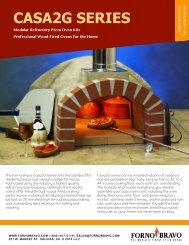Giardino Series Installation.pdf - Forno Bravo
Giardino Series Installation.pdf - Forno Bravo
Giardino Series Installation.pdf - Forno Bravo
You also want an ePaper? Increase the reach of your titles
YUMPU automatically turns print PDFs into web optimized ePapers that Google loves.
<strong>Giardino</strong> <strong>Installation</strong> and Operating Manual12. Curing Your Oven11. Curing Your OvenIt is important at this point that you cure your oven slowly,by building a series of five increasingly larger fires, startingwith a low temperature. If you begin building large fires inyour oven right way, you will compromise your oven'slongevity and ability to cook well, and cause damage,including cracking.After you have installed your oven, there is still a great dealof moisture in the mortars, hearth concrete, vermiculite, andthe oven chamber and vent. Each of these ovencomponents was recently produced using an air-drying,water-based process. Simply letting the oven stand for aweek does not "cure" the moisture out of them oven.Before you start the curing process, let the complete ovensit for one week. Then, start a series of low and growingfires, using the analog temperature gauge provided in theoven door/frame. The temperature gauge reads the oven’sair temperature. For a more accurate temperature readingof the oven refractory surfaces, which can be use for manytypes of cooking, you can use the optional Digital InfraredThermometer, which can be purchased in the <strong>Forno</strong> <strong>Bravo</strong>Store.Day 1. Maintain a fire temperature of 300ºF throughout theday and as long as possible into the evening.Day 2. Repeat at 350ºF.___________________________________________Close the oven door every evening to preserve dryness andheat.Important NotesUse solid wood fuels only. DO NOT use charcoal,pressure treated lumber, chipped wood products, sappywood such as pine, laminated wood or any material otherthan dry medium or hard firewood.Do not use products not specified for use with thisoven.DO NOT USE liquid fuel (firelighter fluid, gasoline, lanternoil, kerosene or similar liquids) to start or maintain a fire.Never use water to lower temperature inside the oven, or toextinguish the fire.There must be a period of time between completing themasonry work and beginning the actual firing cure. Longeris better than shorter, particularly for the actual domecement. The cement and mortar must cure first and thisprocess is actually improved by keeping the cement moistand not letting it dry out.Also, using a space heater can help, but only so far. It is notan alternative to fire curing. We tested a space heater in anassembled <strong>Forno</strong> <strong>Bravo</strong> precast oven for two days, thenquickly heated the oven up, (don't do this at home -- it wasan experiment to see what would happen to an oven thatwe have here) and we found that we created a very largeamount of steam from the oven, mortars and vermiculite,which went on for hours and hours.Important Note. While it is difficult to maintainconsistent, low temperature fires, it is critical forproper curing that you do not go above thesetemperatures during the first two days.___________________________________________Day 3. Repeat at 400ºF.Day 4. Repeat at 450ºF.Day 5. Repeat at 500ºF.© <strong>Forno</strong> <strong>Bravo</strong>, LLC 2010. All Rights Served. Ver. 1.3 41














